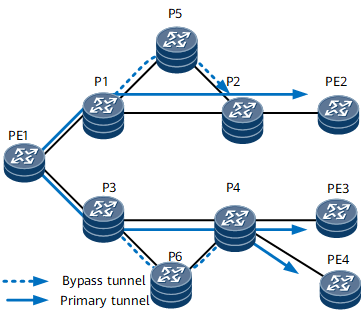Fault on the Local Link - P2MP TE FRR
Fast reroute (FRR) can protect P2MP and P2P TE tunnels. TE FRR establishes a bypass tunnel to protect sub-LSPs. If a link fails, traffic switches to the bypass tunnel within 50 milliseconds.
The P2P TE bypass tunnel is established over the path P1 -> P5 -> P2 on the network shown in Figure 1. It protects traffic over the link between P1 and P2. If the link between P1 and P2 fails, P1 switches traffic to the bypass tunnel destined for P2.
An FRR bypass tunnel must be manually configured. An administrator can configure an explicit path for a bypass tunnel and determine whether or not to plan bandwidth for the bypass tunnel.

A bypass tunnel bandwidth with planned bandwidth can be bound to a specific number of both P2P and P2MP tunnels in configuration sequence. The total bandwidth of the bound P2P and P2MP tunnels must be lower than or equal to the bandwidth of the bypass tunnel.
A bypass tunnel with no bandwidth can also be bound to both P2P and P2MP TE tunnels.
